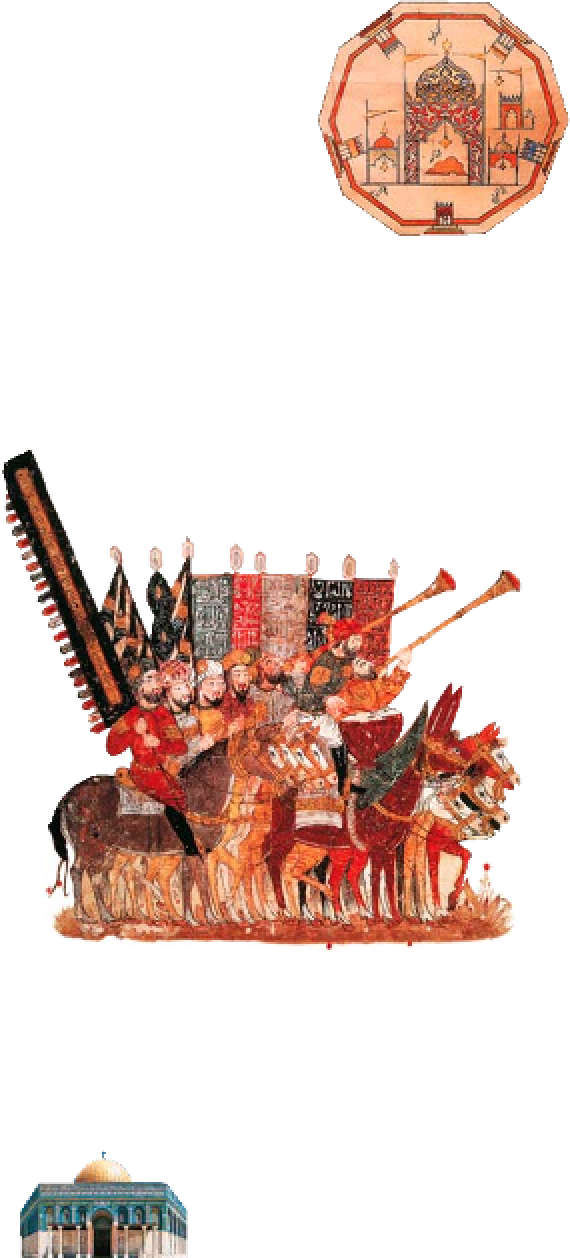Travel Reference
In-Depth Information
614 in the form of an invading Persian
army. Welcomed and supported by the
Jews, who hoped for greater religious
freedom, the Persians massacred the
Christians and desecrated their holy
sites before being driven off in 628 by
the forces of the Byzantine Empire.
In the same year that the
Byzantines reconquered
Palestine, in neighbouring
Arabia an army led by the
Prophet Muhammad con-
quered Mecca, marking
the emergence of a new
force in the Near East
which, in a little over ten
years, would change the face
of the Holy Land.
Arabs regarded Jerusalem as holy in
the same way as the Jews and
Christians. The Arabs also believed
that the Prophet Muhammad had
ascended to Heaven on his Night
Journey
(see p27)
from the same rock
in Jerusalem on which, according to
the Bible, Abraham had been
about to sacrifice his son,
and over which the Jews
had built their temples.
Consequently, the rubble
in the Temple area was
cleared and construction
of two mosques began
there: the Dome of the Rock
(691) and El-Aqsa (705). Access
to this “sacred precinct”
(Haram esh-Sharif)
, was
forbidden to non-Muslims,
but Christians and Jews were permit-
ted to live in the city of Jerusalem on
payment of an “infidels” tax.
Groups of Christian pilgrims regu-
larly arrived in the Holy Land from
Byzantium and Europe and were given
safe passage under the successive Arab
dynasties of the Omayyads (661-750),
Abbasids (750-974) and, initially, the
Fatimids (975-1171). This happy
state of affairs ended in 1009
when the third Fatimid caliph
El-Hakim initiated the violent per-
secu tion of non-Mu slims and
destroyed the Holy Sepulchre. The
situation became critical in 1071
when Jerusalem fell to the Seljuk
Turks, who forbade Christians
access to the Holy City.
The outraged response of
Christian Europe was to take
up arms and set off on the first of
a series of crusades spread over
almost 200 years to recapture
the Holy City and biblical sites
of Palestine
(see pp48-9)
.
Pilgrimage scroll showing
the Haram esh-Sharif
THE ARABS AND ISLAM
In AD 638, only six years after
Muhammad's death, the troops of his
successor, or
caliph
, Omar defeated
the Byzantines at the Yarmuk
Y River, in
modern-day Syria. The Muslims
became the new rulers of Palestine.
Islam recognizes many of the
prophets of the Old Testament, such
as Abraham (Ibrahim), and so the
Triumphant group of the feared Muslim cavalry
747
Earthquake drives
dwindling populations
from Petra and Jerash
1071
Seljuk Turks
capture Jerusalem and
bar Christian pilgrims
Fatimid
jewellery
700
900
1000
1100
800
1099
The Crusaders
take Jerusalem
Dome of
the Rock
975
North African Fatimid
dynasty rules the Holy
Land from Cairo
































